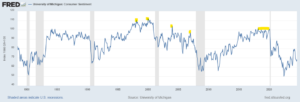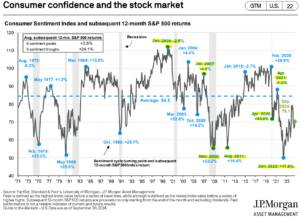“There is a very thin line between confidence and arrogance.” – Adam Peaty, Olympic swimmer
What comes first, confidence or success?
It’s a question I’ve pondered my entire adult life.
How can one have success without confidence? How can one have confidence without success?
You could fake it until you make it (otherwise known as imposter syndrome) and achieve success.
You could get lucky and have some success creating some self-reinforcing mojo for future victories.
I’ve concluded you could make a rational argument for either success or confidence coming first.
However, there’s one discipline where confidence or early success could be disastrous…
Investing.
Confidence can show up at the individual level (known as overconfidence bias). For example, a novice investor buys a stock, the stock quickly goes up 10x, the investor is emboldened by his success and goes on to make additional stock picks (which usually ends poorly).
Confidence can also be captured at the macro-level. There’s a closely followed survey that measures how confident U.S. consumers are feeling every month.

Source: University of Michigan, St. Louis Fed (FRED)
The above chart shows the University of Michigan Consumer Sentiment Survey (1978 – August 2024). The higher the reading, the more confident consumers are about future economic prospects (and vice versa). Notice how consumer sentiment peaks precede recessions (recessions are highlighted by gray columns).
It would seem peaks in consumer sentiment could be a canary in a coal mine before recessions (more on this later).
Can consumer confidence give us insight into stock returns?
 Source: J.P. Morgan Asset Management
Source: J.P. Morgan Asset Management
The above chart shows consumer confidence (gray line) and subsequent 12-month returns for the S&P 500 (blue). A clear pattern emerges; when consumers are confident (gray line moving higher), future stock returns are often lower (see Jan. 2000, Jan. 2007, Feb. 2020, April 2021). Conversely, when consumers are beaten down, future returns are often higher (Oct. 1990, Mar. 2003, Nov. 2008, Apr. 2020, Jun. 2022).
How can a confident consumer be a precursor to recessions and lower or negative future stocks returns?
In my opinion, foolish allocation decisions are overwhelmingly made during good times.
- Chasing performance in the hottest stocks
- Taking on leverage
- Buying more house than you can afford
- Flipping an overpriced house for a quick profit
- Ignoring or disregarding risk
- Unrealistic return expectations
Most of these behaviors happen during prosperous times. Often, they sow the seeds of the next economic implosion.
From our post Stability Breeds Instability May 1, 2019…
“All stable economies sow the seeds of their own destruction.” – Hyman Minsky, Professor of Economics, Washington University.
In other words, “stability breeds instability” is the idea that as people feel good about current economic prospects they tend to consume, take on debt, speculate, etc. Risk-seeking behavior can create imbalances or excesses leading to economic instability.
In my opinion, one of the biggest cases for this bull market continuing is that it hasn’t reached the euphoric levels of consumer sentiment seen previously.
Once consumers become irrationally confident, that could be a good time to pump the brakes. Conversely, when consumers are hunkered down and overly pessimistic, that’s often a good time to take risk (see “Avoiding the Extremes”).
